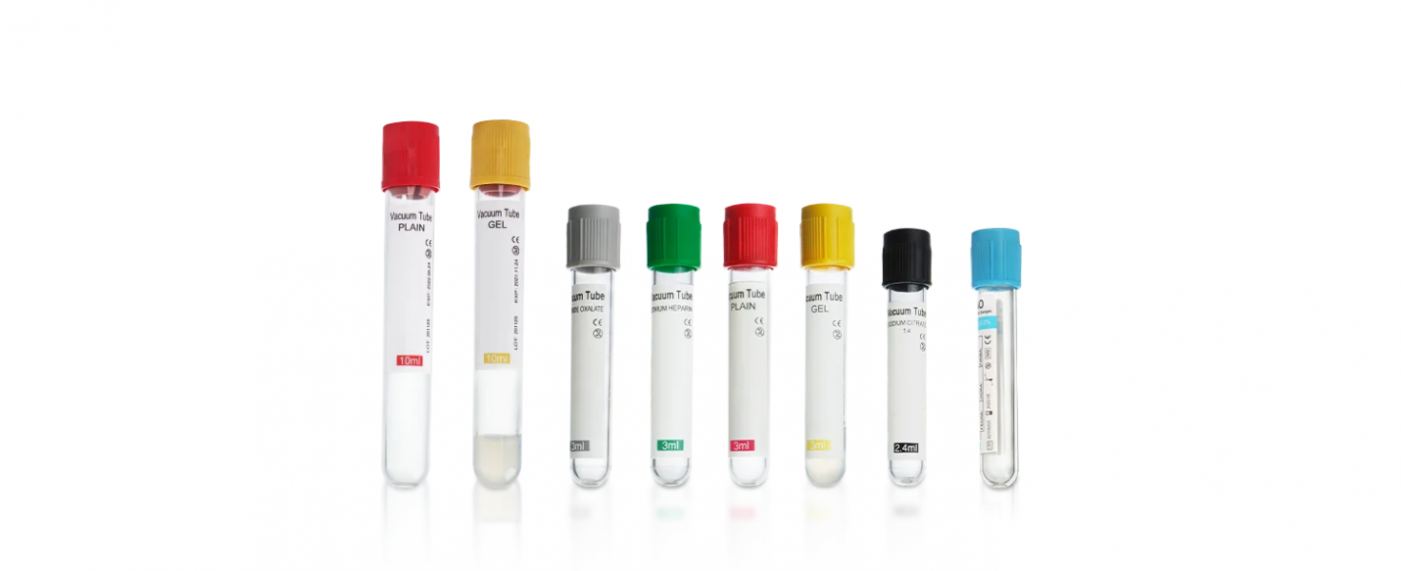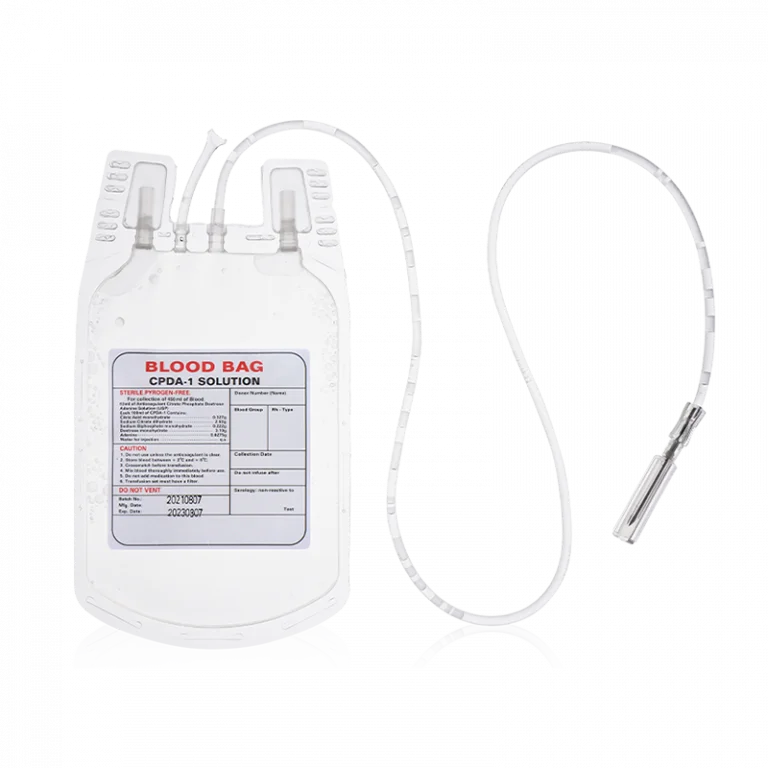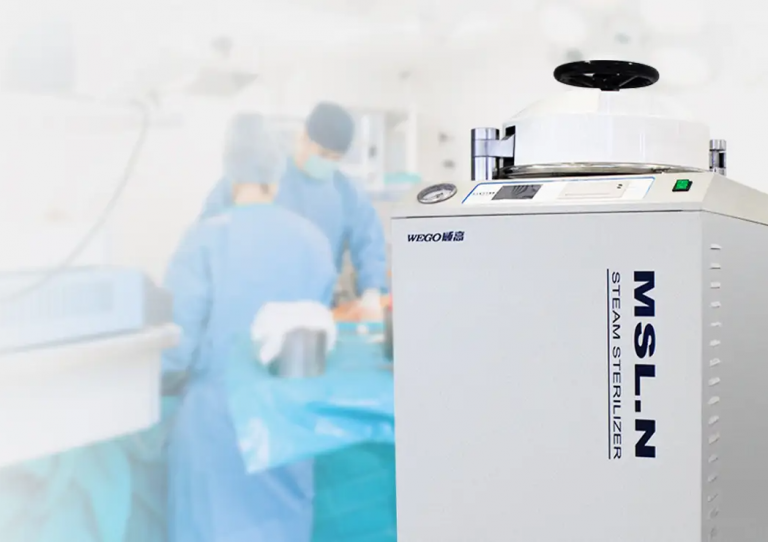Blood collection tubes are medical supplies specifically used for collecting and storing blood samples. They are usually made of glass or PET (polyethylene terephthalate) and designed with sealed caps and labels.
Different blood collection tubes can be used for different testing purposes. The colors on their caps allow laboratory personnel to distinguish the sorts of additives in the tubes and their uses.
High-quality blood collection is crucial in ensuring the stability of samples during collection, transportation, and storage, providing reliable data for clinical diagnosis.
Different Colored Blood Collection Tubes and Their Uses
Each blood vacutainer has a color-coded plastic or rubber cap to differentiate its composition and functions. It’s important to learn what tubes are used for what blood tests.[1] Common types include:
Purple EDTA Tube
The purple-top blood sample tube contains the anticoagulant EDTA. The main role of EDTA is to chelate calcium ions in the blood to prevent their coagulation.
Purple EDTA tubes are used for blood routine examinations and blood ammonia testing. It cannot be used for blood coagulation and trace element testing.
Red Plain Tube
The red plain tube lacks anticoagulants or other additives. Blood will coagulate when in contact with the surface of the vacutainer blood collection. After centrifugation in the blood tubes, separated blood clots and serum can be obtained.
Red plain tubes can be used for the collection of blood samples in clinical biochemistry and immunology.
Yellow GEL Tube
With gel and coagulant, this blood collection tube can separate the liquid components (plasma or serum) and solid components (white blood cells, red blood cells, platelets, fibrinogen, etc.) in the blood after centrifugation.
Yellow GET tubes are used for rapid serum measurements and immunological testing.
Grey Fluoride Tube
Grey blood vacutainer tubes containing sodium fluoride and potassium oxalate can be used for blood coagulation mechanisms and glucose and lactate testing.
Potassium oxalate can inhibit coagulation, while sodium fluoride has a good effect on preventing blood glucose degradation and is excellent for preserving blood glucose.
Green Heparin Tube
Green blood sample tubes contain sodium heparin or lithium heparin, which can inhibit thrombin formation. The type of blood produced in the green tube required for testing is plasma.
It can be used not only for routine clinical biochemistry tests and emergency biochemistry tests but also for blood rheology tests.
Blue PT Tube
The blue blood tube contains 3.8% (0.129 mol/L) sodium citrate to study coagulation. The ratio of the anticoagulant to the blood is 1:9.
Black ESR Tube
The black erythrocyte sedimentation rate (ESR) tube uses 3.2% sodium citrate for the ESR test. 2 mL of blood is needed to be collected to ensure a 1:4 ratio of anticoagulant to blood.
Applications and Considerations for Blood Collection Tubes
Blood tubes play a crucial role in ensuring the quality of blood samples and the accuracy of test results. The following is detailed information about the application, blood drawing sequence, and usage precautions of blood sample tubes:
Application of Blood Collection Tubes
The main applications of blood collection tubes fall into three categories:
- Drug Testing:Monitor therapeutic drug levels in the blood. This is important for monitoring dosages and ruling out toxicity.
- Serum Testing:Serum testing can provide important information about health conditions, including liver function, kidney function, electrolyte balance, lipid levels, etc.
- Blood Testing: Blood testing can provide information including blood routine, immunity, coagulation function, and metabolism.
- Clinical Chemical Testing:It helps analyze information such as electrolyte balance and blood lipids.
What is the Order of Drawing for Blood Collection Tubes?
The CLSI guidelines prescribe a specific order of draw for samples collected from blood vacutainers or syringes to avoid cross-contamination. The industry standard is to first draw non-additive tubes before filling tubes containing additives.
Subsequent blood collection tubes are then filled in this sequence: blood culture bottles, non-additive tubes, sodium citrate tubes (blue), serum tubes (red), heparin tubes (green), EDTA tubes (purple), and sodium fluoride/potassium oxalate tubes (gray). Following this protocol ensures test validity for clinical diagnosis and treatment. [2]
Precautionsfor Using Blood Collection Tubes
Using blood collection tubes requires caution at each step to deliver meaningful laboratory results. Both sample quality and patient safety must be priorities when drawing blood with a vacutainer. Key precautions include:
- Pay attention to the correct sequence of drawing blood with a vacutainer according to CLSI guidelines
- Prevent contamination of vacutainer blood collections before, during, and after collection
- Ensure adequate mixing of tubes containing additives
- Transport and store blood tubes within manufacturer-specified temperature ranges
- Clearly label each blood collection tube with patient information and test requests
- Adhere to expiration dates printed on tubes
Where to Buy High-Quality Blood Vacutainer?
WEGO Medical is your trusted partner in the medical field, committed to providing excellent healthcare solutions globally. We specialize in the development and sale of medical consumables, such as blood collection tubes.
These blood collection tubes include the EDTA tube, plain tube, GEL tube, fluoride tube, plasma tube, PT tube, and ESR tube. Choosing WEGO Medical provides distinct advantages, such as:
- International standardization in color-coding for simple identification
- Flexibility through OEM and ODM customization
- Rigorous quality control ensures sterility and good sealing capability
- Multiple material options, like glass or PET tubes
- Ordinary vacutainer blood collection tubes and high blood vacutainer tubes are available.
Conclusion
Color-coded blood collection tubes serve as crucial tools for medical testing. When drawing blood with a vacutainer, the use of high-quality blood collection tubes is significant for ensuring the quality of samples and the accuracy of test results.
WEGO Medical strives to support healthcare facilities and ensure diagnostic accuracy. Through continuous innovation, we ensure our tubes safely and effectively support diagnostic needs. Contact us to learn more about our blood collection tubes and other medical solutions.
References
[1] Laboratory Tube Collection. Available at: https://www.ncbi.nlm.nih.gov/books/NBK555991/ (Accessed: 28 May 2024)
[2] Order of Blood Draw Tubes and Additives. Available at: https://clsi.org/about/blog/order-of-blood-draw-tubes-and-additives/ (Accessed: 28 May 2024)











